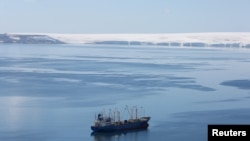Krill are tiny crustaceans that are a large source of food for whales and other water mammals. But they are also in demand by private industry for use in medicine and fish food.
A humpback whale became trapped in a krill net last month and died in the Southern Ocean. Three young humpbacks were caught in the same company’s krill nets last year.
The nets were from fishing company Aker BioMarine, based in Norway. It said these were its first cases of catching whales in 15 years of trawling for krill in Antarctica. The company also said it has made improvements to its equipment to keep mammals like whales out of its nets.
The krill industry is set to grow quickly over the next several years. Countries including China and Russia have planned new investments in the business. Scientists are worried krill trawling could threaten Antarctic wildlife.
The krill trawlers target the same feeding areas as fur seals, humpback whales, and blue whales. Studies have also found penguins must swim for longer periods in search of food when fishing boats are nearby.
Krill fishing “doesn’t bode well for our global fisheries,” said Teale Phelps Bondaroff of the non-profit OceansAsia. “It means we're getting to the end of what's available in our oceans.”
The icy waters off Antarctica are estimated to hold between 300 million and 500 million tons of krill.
Antarctic krill is well researched, compared with the 84 other krill species in the world's oceans. Governments have mostly not opened new krill fisheries due to conservation concerns. But both Japan and Canada operate small krill fisheries in the North Pacific.
In Antarctica, about 11 ships from China, Norway, South Korea, Ukraine and Chile trawl the area’s waters from December to July. Rules under the Antarctic Treaty System require trawlers to stay on four areas off the Antarctic Peninsula. They can catch at most 620,000 tons - less than 2 percent of all krill.
Trawlers have not yet taken the full amount. But in 2020, they caught 450,000 tons. That was the most recorded in many years.
"If we introduce just a couple more big trawlers, we will reach (620,000) tons very easily," said Rodolfo Werner. He is with the Antarctic and Southern Coalition, a group of environmental non-profits.
The world's krill industry is growing quickly. The $531-million market for krill oil is expected to rise to $941 million by 2026, research has found.
Pål Skogrand is with the company Aker BioMarine. He said krill should not only be for wildlife. "Krill contain so many good elements" for humans, too, he said.
Krill is used as feed for fish farming. Fish farming is the world's fastest growing food area. Experts expect global demand for fish to double by 2050.
Pressure on supply
Even without competition from fisheries, the krill supply is under increasing pressure. Climate change and higher numbers of whales is decreasing the supply for trawlers.
A 2016 study in the journal Geophysical Research Letters found warmer waters and increased ice melt could drive krill numbers down about 30 percent this century. And a single humpback whale in the West Antarctic Peninsula eats up to 3.1 tons of krill a day. The area has an estimated 3,000 humpbacks.
In October, the Commission for the Conservation of Antarctic Marine Living Resources will consider changing catch limits and trawling areas because of conservation concerns.
Scientists fear some nations may oppose stricter measures. China and Russia, for example, have often opposed efforts to create Marine Protected Areas.
I’m Dan Novak.
Dan Novak adapted this story for VOA Learning English based on reporting by Reuters.
________________________________________________________________
Words in This Story
crustacean — n. a type of animal such as a crab or lobster that has several pairs of legs and a body made up of sections that are covered in a hard outer shell
trawl — n. a large net that a boat pulls along the bottom of the ocean to catch fish
bode — v. to be a sign of a future event or situation
global — adj. involving the entire world
conservation — n. the protection of animals, plants, and natural resources









